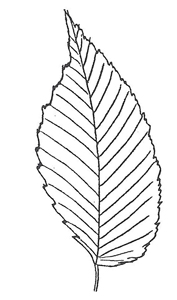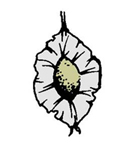Ulmus americana (ul’-mus a-mer-i-ka-na)
Family: Ulmaceae, Elm
Key Steps
- 1b – Alternate leaf arrangement — go to 18
- 18a – Leaf simple — go to 19
- 19b – Thornless — go to 22
- 22e – All leaves unlobed — go to 31
- 31d – Leaf is oval or oblong (twice as long as wide) — go to 41
- 40a – Leaf base asymmetrical — go to 41
- 41c – 1 main vein — go to 42
- 40a – Leaf base asymmetrical — go to 41
- 31d – Leaf is oval or oblong (twice as long as wide) — go to 41
- 22e – All leaves unlobed — go to 31
- 19b – Thornless — go to 22
- 18a – Leaf simple — go to 19
Description
 Leaf: To 6 inches long. Double-toothed margin. Long, narrow tip, widest at middle or above. Uneven base. Pinnate venation, parallel veins extend from central vein to margin. May be very rough above, like sandpaper, in texture. Medium to dark green. Short petiole.
Leaf: To 6 inches long. Double-toothed margin. Long, narrow tip, widest at middle or above. Uneven base. Pinnate venation, parallel veins extend from central vein to margin. May be very rough above, like sandpaper, in texture. Medium to dark green. Short petiole.
Bud: Round flower buds. Leaf buds very tiny, narrow. Buds are reddish-brown or blackish. May be tipped to one side or the other of leaf scar. Bud scales (4 or more) may be 2 ranked (two vertical rows). Scales edged in black. True terminal bud absent.
Leaf Scar: Half round. Bundle scars when visible are in groups of 3, sunken.
Stem: Slender, slightly zigzag, may be in a “fishbone” or herringbone pattern.
Bark: Gray-brown deep intersecting furrows. Older, upper bark sometimes black from sooty mold.
Pith: White, solid.
 Flower: On slender drooping stalk, before leaves appear. In clusters on old stems at buds.
Flower: On slender drooping stalk, before leaves appear. In clusters on old stems at buds.
Fruit: Small, flat, oval to circular, papery, notched at tip, 1/3 inch diameter. Long-stemmed. Hairless except for margin. One seed.
Habit: Vase-shaped. Large shade tree, 40+ feet tall.
Culture: Moderate moisture. Develops Dutch Elm Disease.
Resources




